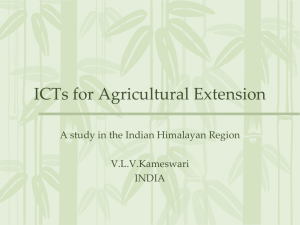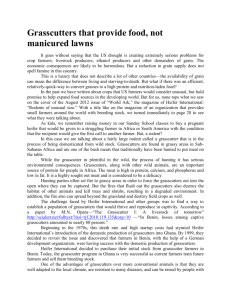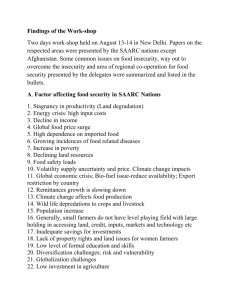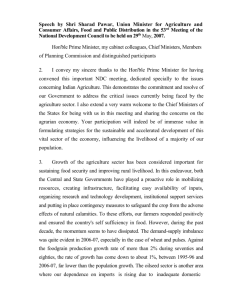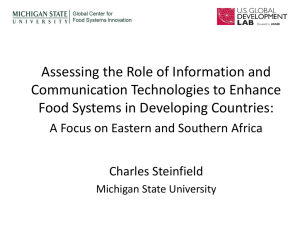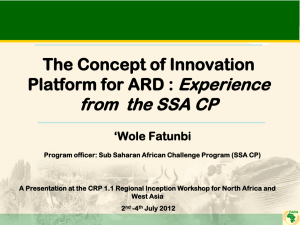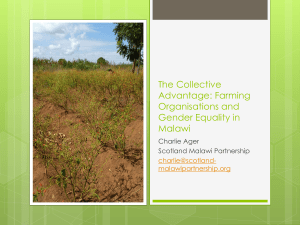Presentation
advertisement
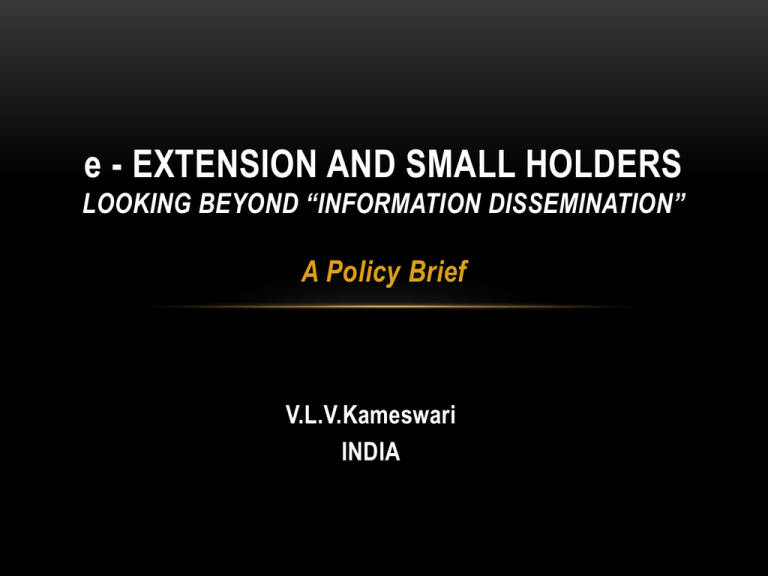
e - EXTENSION AND SMALL HOLDERS LOOKING BEYOND “INFORMATION DISSEMINATION” A Policy Brief V.L.V.Kameswari INDIA INTRODUCTION • Indian agriculture is characterized by low productivity, subsistence farming, minimal inputs and distress sale at low paying outlets. • The sector is facing several challenges due to changes at the local, national and international levels. • The Public Extension System in India has undergone several changes to overcome the challenges facing the sector. • One of the strategies adopted is the increasing use of ICTs to reach farmers. THE STUDY • There is a strong evidence to suggest that ICTs are rarely used by the farmers’ to access agricultural information. • The study was carried out to understand the media use and information seeking behavior of farmers. • It focused on how availability of market and productivity influence use of ICTs by the farmers. METHODOLOGY • The study was conducted in 8 villages from four districts in a North Indian state. • The state of Uttarakhand is divided into two divisions. • Each division was divided into two zones (lower and middle hills). • One district was selected from each zone in the division. • Close and open ended Interview schedules was used for data collection. STUDY SITE • The task of providing extension services is mainly confined to the government agencies. • National Extension System India came into being in 1952. • Since then, the system has passed through various stages to adapt itself to the changing needs of the society. • Agricultural extension acquired a well defined shape and became goal oriented during the second phase of National Extension System (NSE) starting from 1960. STUDY SITE FINDINGS 90 80 70 60 50 40 30 20 10 0 Landless Marginal Small Medium Large RECOMMENDATION 1: NURTURING COOPERATIVES • Form and nurture cooperatives. • Increase access to agricultural services including extension advice. • Public Extension System can come to a cost/ revenue sharing arrangement with these local institutions. • Ensure intensive and board based extension support. FINDINGS 90 Mobile phone 80 Television 70 60 50 40 30 20 10 Internet 0 Radio Newspaper Fixed phone RECOMMENDATION 2: m - EXTENSION • High ownership, low cost and wide reach. • ICT based initiatives in agriculture should mainly focus on use of mobile technologies. FINDINGS • Farmers in the study area received agricultural information from a wide range of sources/ channels. • Maximum number of farmers (62%) approached private input dealers (seed and pesticide suppliers)/ middlemen (adti) for information. • This heavy dependence on adti was due to absence or inaccessibility of formal institutions to farmers. FINDINGS RECOMMENDATION 3: BROADBASING EXTENSION • Needs of the farmers go way beyond simple need for information on improved technologies. • Hence, there is a need to expand the notion of extension worker from narrow confines of information provider (subject specificity). • Reorient to provide first level assistance on all aspects of agricultural value chain (multi dimensionality). FINDINGS Use mobile phones for post sale inquiry rather than presale negotiations: • Constrained by structural factors and environmental conditions. • Lack of market and cold storage facilities. • Interrelated nature of informal institutions. • Trust and social norms play an important role in business transactions in rural areas. RECOMMENDATION 4: SYSTEM APPROACH • Efficiency in agriculture is interlinked with several factors. • e- extension initiatives cannot succeed in a contextual vacuum. • Agricultural Policy should follow a systems approach where by all factors are addressed simultaneously. SUMMING THE RECOMMENDATIONS • Nurturing cooperatives • Broadbasing extension • m-extension • Systems approach CONCLUSION • This study indicates that the possible advantages from use of ICTs were offset due to absence of other conducive factors. • Interventions in other parts of the World and India show that the entire agricultural supply chain can be made more efficient by use of ICTs. • Information, through ICTs or conventional methods, can at best only be an intervening variable. ACKNOWLEDGEMENT This policy brief is an outcome of the study supported by Strengthening ICTD Research Capacity in Asia (SIRCA). We would like to thank SIRCA for funding and facilitating the study.
